Alexey Varochko, general director of the M.V. Khrunichev Space Research and Production Centre, said that the first “Angara-A5V” rocket will be launched no sooner than 2028, following the completion of flight tests of the new KVTs (Space Rocket Stage).
The preliminary design of the “Angara-A5V” carrier rocket has been successfully finished, according to the General Director, who noted that the Khrunichev Centre has achieved this goal.
He explained to RIA Novosti that the elements of the top stage are currently undergoing the manufacturing process in preparation for independent testing. Both ground-based and airborne verification techniques will be developed in order to ensure that the products comply with the technical specifications.
The next phase will involve the production of bench products, which will be comprised of a multitude of CVTK systems and individual units. An examination of the KVTK’s launch, technical complex, and fueling mock-up will be carried out by specialists from the Khrunichev Centre prior to the flight testing of the upper stage.
The heavy-class Angara-A5, Angara-A5M, and Angara-A5V missiles are all expected to make use of the KVTK (heavy-class oxygen-hydrogen) upper stage in the near future. Because of this, the Angara-A5M rocket, which will be launched from the Vostochny cosmodrome, will be able to place a payload with a mass of 5 tonnes into geostationary orbit (a circular orbit at an altitude of approximately 36,000 kilometres), while the Angara-A5B rocket will be able to place a payload with a mass of 7.5 tonnes into geostationary orbit. This will be several tonnes more than when employing the upper stages that are already in place.
Before, the beginning of flight tests for the super-heavy “Angara-A5V” rocket at the Vostochny Cosmodrome was scheduled to take place in the year 2027.
The “Angara” series includes environmentally friendly carrier rockets of various classes, including light carriers (“Angara-1.2”), medium carriers (“Angara-A3”), and heavy carriers (“Angara-A5”), as well as the upgraded (“Angara-A5M”), piloted (“Angara-A5P”), and expanded payload capacity (“Angara-A5V”) versions of these rockets.

The Angara’s modular design is one of its defining features. The Angara family of launch vehicles traces its origins back to the design and construction of the URM-1 and URM-2 universal rocket modules. A rocket can be built with fewer, more, or the same number of bricks depending on its intended weight, exactly like a Lego model.
The “Proton-M” rockets are being replaced in the production line at the Khrunichev Centre by the “Angara” rockets, which will eventually lead to the complete retirement of the “Proton-M” rockets. The Moscow plant is scheduled to finish manufacturing the last four “Proton-M” launch vehicles this year, which will mark the end of the programme. The personnel engaging in this procedure are readily shifting over to the construction of the third stage of the ‘Angara-A5’ rocket, and the rocket is being assembled in the same workshop. The International Space Station is going to receive supplies using this rocket.
Additionally, Khrunichev’s Moscow facility intends to build all test models and flight gear to develop the oxygen-hydrogen Space Rocket Stage and the oxygen-hydrogen third stage of the ‘Angara-A5V’ rocket. At the Vostochny Cosmodrome, specialised hardware to refuel the carrier rocket is already being fabricated.

